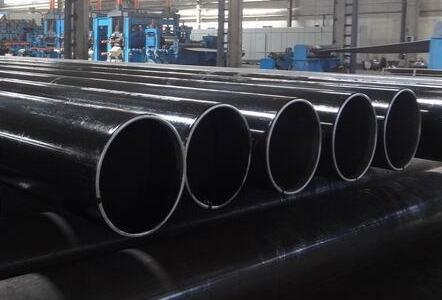High-frequency welding is a new welding process that uses the skin effect and adjacent effect produced by high-frequency current to join steel plates and other metal materials. The emergence and maturity of high-frequency welding technology is a key process in the production of straight seam welded pipes (ERW pipes). The quality of high-frequency welding directly affects the overall strength, quality level and production speed of welded steel pipe products.
The so-called high frequency is relative to the AC current frequency of 50Hz, generally referring to the high-frequency current of 50KHz~400KHz. When high-frequency current passes through a metal conductor, it will produce two peculiar effects: skin effect and proximity effect. High-frequency welding uses these two effects to weld steel pipes. So, what are these two effects?

The skin effect means that when an alternating current of a certain frequency passes through the same conductor, the density of the current is not uniformly distributed across all cross-sections of the conductor. It will mainly concentrate on the surface of the conductor. That is, the density of current on the surface of the conductor is large, but the density inside the conductor is small, so we vividly call it the "skin effect". The skin effect is usually measured by the penetration depth of the current. The smaller the penetration depth value, the more significant the skin effect is. This depth of penetration is directly proportional to the square root of the conductor's resistivity and inversely proportional to the square root of frequency and permeability. In layman's terms, the higher the frequency, the more concentrated the current is on the surface of the steel plate; the lower the frequency, the more dispersed the surface current is. It must be noted that although steel is a conductor, its magnetic permeability will decrease as the temperature increases. That is to say, when the temperature of the steel plate increases, the magnetic permeability will decrease and the skin effect will decrease.
Proximity effect means that when high-frequency current flows in opposite directions in two adjacent conductors, the current will flow concentratedly toward the adjacent edges of the two conductors. Even if the two conductors have a shorter side, the current does not flow along the shorter route. We call this effect the "proximity effect".
The proximity effect is essentially due to the effect of inductive reactance, which plays a dominant role in high-frequency currents. The proximity effect increases as the frequency increases and the distance between adjacent conductors becomes closer. If a magnetic core is added around the adjacent conductor, the high-frequency current will be more concentrated on the surface of the workpiece.
These two effects are the basis for realizing high-frequency welding of metals. High-frequency welding uses the skin effect to concentrate the energy of high-frequency current on the surface of the workpiece; and uses the proximity effect to control the position and range of the high-frequency current flow path. The speed of the current is very fast, and it can heat and melt the edges of adjacent steel plates in a very short time, and achieve docking through extrusion.
The so-called high frequency is relative to the AC current frequency of 50Hz, generally referring to the high-frequency current of 50KHz~400KHz. When high-frequency current passes through a metal conductor, it will produce two peculiar effects: skin effect and proximity effect. High-frequency welding uses these two effects to weld steel pipes. So, what are these two effects?

The skin effect means that when an alternating current of a certain frequency passes through the same conductor, the density of the current is not uniformly distributed across all cross-sections of the conductor. It will mainly concentrate on the surface of the conductor. That is, the density of current on the surface of the conductor is large, but the density inside the conductor is small, so we vividly call it the "skin effect". The skin effect is usually measured by the penetration depth of the current. The smaller the penetration depth value, the more significant the skin effect is. This depth of penetration is directly proportional to the square root of the conductor's resistivity and inversely proportional to the square root of frequency and permeability. In layman's terms, the higher the frequency, the more concentrated the current is on the surface of the steel plate; the lower the frequency, the more dispersed the surface current is. It must be noted that although steel is a conductor, its magnetic permeability will decrease as the temperature increases. That is to say, when the temperature of the steel plate increases, the magnetic permeability will decrease and the skin effect will decrease.
Proximity effect means that when high-frequency current flows in opposite directions in two adjacent conductors, the current will flow concentratedly toward the adjacent edges of the two conductors. Even if the two conductors have a shorter side, the current does not flow along the shorter route. We call this effect the "proximity effect".
The proximity effect is essentially due to the effect of inductive reactance, which plays a dominant role in high-frequency currents. The proximity effect increases as the frequency increases and the distance between adjacent conductors becomes closer. If a magnetic core is added around the adjacent conductor, the high-frequency current will be more concentrated on the surface of the workpiece.
These two effects are the basis for realizing high-frequency welding of metals. High-frequency welding uses the skin effect to concentrate the energy of high-frequency current on the surface of the workpiece; and uses the proximity effect to control the position and range of the high-frequency current flow path. The speed of the current is very fast, and it can heat and melt the edges of adjacent steel plates in a very short time, and achieve docking through extrusion.









